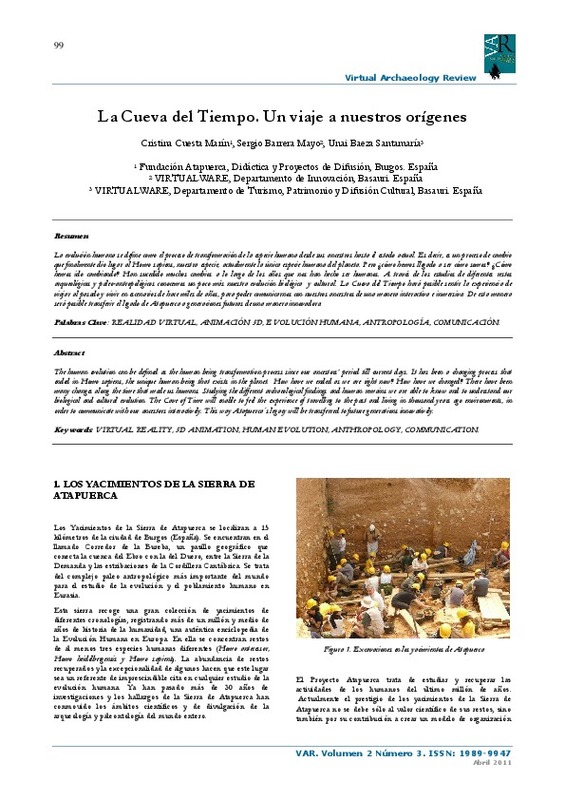JavaScript is disabled for your browser. Some features of this site may not work without it.
Buscar en RiuNet
Listar
Mi cuenta
Estadísticas
Ayuda RiuNet
Admin. UPV
La Cueva del Tiempo. Un viaje a nuestros orígenes
Mostrar el registro sencillo del ítem
Ficheros en el ítem
| dc.contributor.author | Cuesta Marín, Cristina
|
es_ES |
| dc.contributor.author | Barrera Mayo, Sergio
|
es_ES |
| dc.contributor.author | Baeza Santamaría, Unai
|
es_ES |
| dc.coverage.spatial | east=-3.5194995; north=42.3489426; name=Atapuerca, Burgos, Espanya | es_ES |
| dc.date.accessioned | 2020-03-26T07:29:28Z | |
| dc.date.available | 2020-03-26T07:29:28Z | |
| dc.date.issued | 2011-04-15 | |
| dc.identifier.uri | http://hdl.handle.net/10251/139478 | |
| dc.description.abstract | [ES] La evolución humana se define como el proceso de transformación de la especie humana desde sus ancestros hasta el estado actual. Es decir, es un proceso de cambio que finalmente dio lugar al Homo sapiens, nuestra especie, actualmente la única especie humana del planeta. Pero ¿cómo hemos llegado a ser cómo somos? ¿Cómo hemos ido cambiando? Han sucedido muchos cambios a lo largo de los años que nos han hecho ser humanos. A través de los estudios de diferentes restos arqueológicos y paleo-antropológicos conocemos un poco más nuestra evolución biológica y cultural. La Cueva del Tiempo hará posible sentir la experiencia de viajar al pasado y vivir en escenarios de hace miles de años, para poder comunicarnos con nuestros ancestros de una manera interactiva e inmersiva. De esta manera será posible transferir el legado de Atapuerca a generaciones futuras de una manera innovadora. | es_ES |
| dc.description.abstract | [EN] The human evolution can be defined as the human being transformation process since our ancestors’ period till current days. It has been a changing process that ended in Homo sapiens, the unique human being that exists in the planet. How have we ended as we are right now? How have we changed? There have been many changes along the time that made us humans. Studying the different archaeological findings and human remains we are able to know and to understand our biological and cultural evolution. The Cave of Time will enable to feel the experience of travelling to the past and living in thousand years ago environments, in order to communicate with our ancestors interactively. This way Atapuerca´s legacy will be transferred to future generations innovatively. | es_ES |
| dc.description.sponsorship | Este proyecto está financiado por el Ministerio de Industria, Turismo y Comercio (MITYC) a través del Plan Avanza 2009, expediente: TSI-070100-2009-387. | es_ES |
| dc.language | Español | es_ES |
| dc.publisher | Universitat Politècnica de València | es_ES |
| dc.relation.ispartof | Virtual Archaeology Review | es_ES |
| dc.rights | Reconocimiento - No comercial - Sin obra derivada (by-nc-nd) | es_ES |
| dc.subject | Virtual reality | es_ES |
| dc.subject | 3D animation | es_ES |
| dc.subject | Human evolution | es_ES |
| dc.subject | Anthropology | es_ES |
| dc.subject | Communication | es_ES |
| dc.subject | Realidad virtual | es_ES |
| dc.subject | Animación 3D | es_ES |
| dc.subject | Evolución humana | es_ES |
| dc.subject | Antropología | es_ES |
| dc.subject | Comunicación | es_ES |
| dc.title | La Cueva del Tiempo. Un viaje a nuestros orígenes | es_ES |
| dc.type | Artículo | es_ES |
| dc.identifier.doi | 10.4995/var.2011.4621 | |
| dc.relation.projectID | info:eu-repo/grantAgreement/MITURCO//TSI-070100-2009-0387/ES/La Cueva del Tiempo, diseño y montaje expositivo de una sala de realidad virtual estereoscópica permanente e itinerante, que permita sentir la experiencia de viajar en el tiempo y vivir en escenarios de hace miles de años/ | es_ES |
| dc.rights.accessRights | Abierto | es_ES |
| dc.description.bibliographicCitation | Cuesta Marín, C.; Barrera Mayo, S.; Baeza Santamaría, U. (2011). La Cueva del Tiempo. Un viaje a nuestros orígenes. Virtual Archaeology Review. 2(3):99-103. https://doi.org/10.4995/var.2011.4621 | es_ES |
| dc.description.accrualMethod | OJS | es_ES |
| dc.relation.publisherversion | https://doi.org/10.4995/var.2011.4621 | es_ES |
| dc.description.upvformatpinicio | 99 | es_ES |
| dc.description.upvformatpfin | 103 | es_ES |
| dc.type.version | info:eu-repo/semantics/publishedVersion | es_ES |
| dc.description.volume | 2 | es_ES |
| dc.description.issue | 3 | es_ES |
| dc.identifier.eissn | 1989-9947 | |
| dc.relation.pasarela | OJS\4621 | es_ES |
| dc.contributor.funder | Ministerio de Industria, Turismo y Comercio | es_ES |
| dc.description.references | ARSUAGA, JUAN LUIS y MARTÍNEZ, I. (1998): "La especie elegida. La larga marcha de la Evolución Humana". Temas de Hoy. Madrid. | es_ES |
| dc.description.references | BERMÚDEZ DE CASTRO, J.M. (2004): "Hijos de un tiempo perdido. La búsqueda de nuestros orígenes". Ares y Mares. Barcelona. | es_ES |
| dc.description.references | CARBONELL, E. (2005): "Homínidos: las primeras ocupaciones de los continentes". Ariel. Barcelona. | es_ES |
| dc.description.references | DÍEZ, C.; MORAL, S.; NAVAZO, M. (2009): "La Sierra de Atapuerca. Un viaje a nuestros orígenes". Everest. León. | es_ES |
| dc.description.references | NVIDIA (2005): "GPU Programming guide 2.4.0". NVidia. | es_ES |
| dc.description.references | WILLIAMS, R. (2001): "The animator's survival kit: a manual of methods, principles and formulas for classical, computer, games, stop motion and Internet animators". Faber & Faber. Londres. | es_ES |








